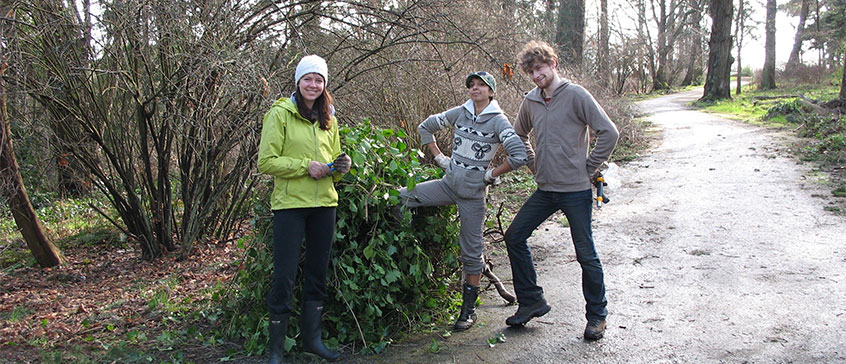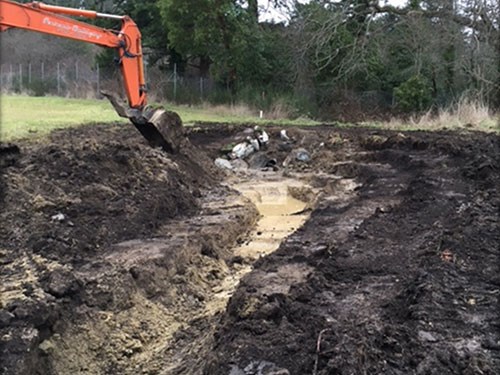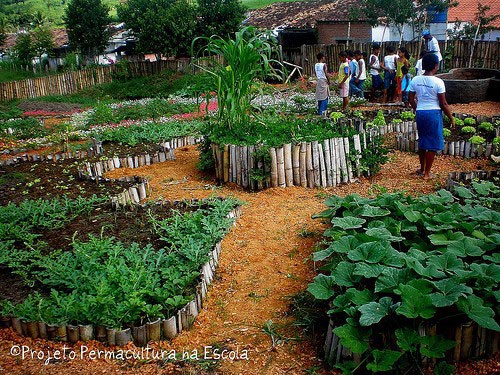Home / Science and the Environment / Balancing the books: Ecological restoration programs take people and nature into account
Balancing the books: Ecological restoration programs take people and nature into account

By Val Schaefer and Laura Biggs, Restoration Programs, University of Victoria
This article was originally published in the August 2017 BC Society of Landscape Architects (BCSLA) Sitelines Magazine. It has been reprinted with permission from the BCSLA and Dr. Valentin Schaefer.
The Environmental Studies program in the Faculty of Social Sciences at the University of Victoria was developed in 1978 and is one of the first environmental studies degree programs in Canada. Its first full-time faculty member was a philosopher, indicating that an interdisciplinary, holistic approach was woven into the very fabric of the curriculum. Today, half of the faculty are from the sciences. The program has a balance between scientific and social knowledge at its core, a balance between nature and people.
The 1990s was a formative decade for ecological restoration in British Columbia. The environment was a priority with the NDP government of the time, leading to the genesis of provincial programs in forest renewal, fisheries renewal and watershed restoration. Universities, colleges and institutes in BC initially met the need for further training and education in these areas primarily by modifying their existing programs in biology, geography and geology. In 1991, the BC Environmental Programs Articulation Committee was formed by the BC Ministry for Advanced Education, Training and Technology, to better organize and coordinate the proliferation of new changes and programs.
The Society for Ecological Restoration was formed in 1987 and the field of ecological restoration emerged with a curriculum of its own. The field of urban ecology was growing as a specialization in the 1980s as well. Ecological restoration began to accumulate its own body of knowledge and integrated philosophy, indigenous values and sociology. Eventually, new certificates, diploma and degrees in ecological restoration were developed. A science-based curriculum still figures heavily in many of the programs for resource sectors such as forestry, mining and fisheries. However, ecological restoration in cities is different than in natural areas. It requires a sensitivity to and understanding of urban planning, social values, consensus building, conflict resolution and dealing with the added uncertainty of nature’s interaction with people in an urban setting.
The Restoration of Natural Systems (RNS) program was started by the School of Environmental Studies in 1996. A few years later, the passage of the Species at Risk Act in 2004 shone a spotlight on Garry Oak ecosystems that suffered heavy impacts from urban development in the City of Victoria in particular, bringing an even stronger focus on the relationship between urban ecology and ecological restoration. Although our restoration programs are offered nationally and internationally, a significant amount of inspiration for our curriculum comes from our experiences in Victoria, metro Vancouver and the rest of BC. About one-third of our students are local, another third are from the rest of BC, and the remainder are from other provinces or internationally.
Ecological restoration programs at UVic
The University of Victoria offers two programs in ecological restoration benefitting from a partnership that brings together content expertise from the School of Environmental Studies and the sensitivity to adult learner needs and online teaching expertise from the Division of Continuing Studies. Our curriculum teaches viable approaches that consider ecological, social and political dimensions, as well as the problem-solving skills to identify and resolve conflicts and to build consensus in the decision-making process. We also offer some customized contract training that leads to a Certificate of Completion on request.
The RNS program was established in 1996 to provide both theoretical knowledge and practical skills for those working to restore damaged ecosystems. It provides a holistic approach to restoration projects, recognizing the importance of both the social and biophysical dimensions of restoration work.
Offered as both a 12-course credit diploma and a shorter eight-course non-credit certificate option, the RNS program is designed to meet the needs of professionals and to suit the busy schedules of people who work or study full-time. Courses are offered in two formats: on-campus five-day intensive or online. The RNS program is at the third- and fourth-year undergraduate level and often attracts students who are concurrently working on an undergraduate degree. However, many of our students are working professionals who already have degrees and are looking for professional development and specialization in the field of ecological restoration. Some RNS diploma graduates have continued on to do an MA or MSc in Environmental Studies in ecological restoration.
All diploma and certificate students are required to complete an applied project to give them real life experience about what is involved in conducting a project—known as ER390. In the process, they gain applied knowledge of community consultations, permits, community plans, working on teams, organizing volunteers and other relevant aspects. Depending on the interests and opportunities available to the student, the project may be as simple as an invasive species removal (image above) or as complex as excavating stream channels (Fig. 2). Students who have connections with international organizations have done projects in places such as Nicaragua, Kenya, Sierra Leone (Fig. 3) and the Philippines.
 Fig. 2. Excavating a new stream channel for Grosbeak Creek in Saanich, BC. Credit: Strong
Fig. 2. Excavating a new stream channel for Grosbeak Creek in Saanich, BC. Credit: Strong
 Fig. 3. Re-vegetating drilling platforms in Panama. Credit: Rokosh
Fig. 3. Re-vegetating drilling platforms in Panama. Credit: Rokosh
The Ecological Restoration (ER) program is a non-credit professional specialization certificate (PSC) taught at a post-baccalaureate level for people working in ecological restoration and related fields, and who are seeking advanced training. Students in this program already have a degree and some experience in an environmental field. The ER program develops critical thinking skills and asks challenging questions that require students to deal with the uncertainty that is present with more complex problems in ecological restoration. Students take four of the five courses offered, all of which are full-term and online. Upon completion of the PSC, students are able to conduct detailed site assessments and restoration projects that pay special attention to the unique conditions and challenges presented by altered environments. The program focuses on: 1) re-establishing natural processes, 2) balancing social and economic constraints with ecosystem functioning, 3) exploring new approaches to creating functional landscapes, 4) challenging our current understanding of ecological restoration as it is applied to a wide range of conditions, and 5) adapting to climate change.
Our graduates include a number of landscape architects, including Bev Windjack and Kristina Zalite who have contributed articles here. Bev has completed both the RNS diploma program and the PSC in Ecological Restoration. Kristina has completed the RNS diploma. Marika Smith, another contributor, is also an RNS graduate.
The contract training has involved short 1 to 2 day programs in ecological restoration with First Nations such as the Songhees and Homolko, and with community groups such as the Stewardship Centre for BC, with whom we offer their Green Shores Program (described later).
Our partnerships
The RNS program engages with government, businesses and the community through 1) student projects, 2) program-level projects and 3) community outreach activities. The over 100 community partners we have worked with over the years have enriched the learning opportunities for our students and have kept the program current and relevant. In return, our partners have benefitted from the time and expertise of our talented students in conducting important work to understand, restore and live in harmony with the natural environment. Our community partners have come from all levels of government, First Nations, educational institutions, international organizations, non-governmental organizations, consulting firms and other private partners. Our community outreach includes activities such as lecture series, restoration walks and the Garry Oak Ecosystem Recovery Team (GOERT) Research Colloquium.
RNS student technical series papers
Each student in the RNS program is required to conduct a major, semester-long project—ER390 (described above). The work of these students to plan and implement a real restoration project highlights the extensive reach and positive impact of this program. Their reports represent a substantial resource and most of these are available online.
- Posted January 31, 2018
RELATED TOPICS: Ecological RestorationSustainability
Latest News
- The value of project management and how it benefits every industry
- Empowering the next generation of entrepreneurs
- Embracing professional growth with the Diploma in Business Administration program
- Business graduate makes a positive career pivot
- A Cultural Journey of Learning Japanese
Visit Registration
2nd Floor | Continuing Studies Building University of Victoria Campus 3800 Finnerty Road | Victoria BC | CanadaTel 250-472-4747 | Email uvcsreg@uvic.ca
2024 © Continuing Studies at UVic
Legal Notices |
Sitemap

